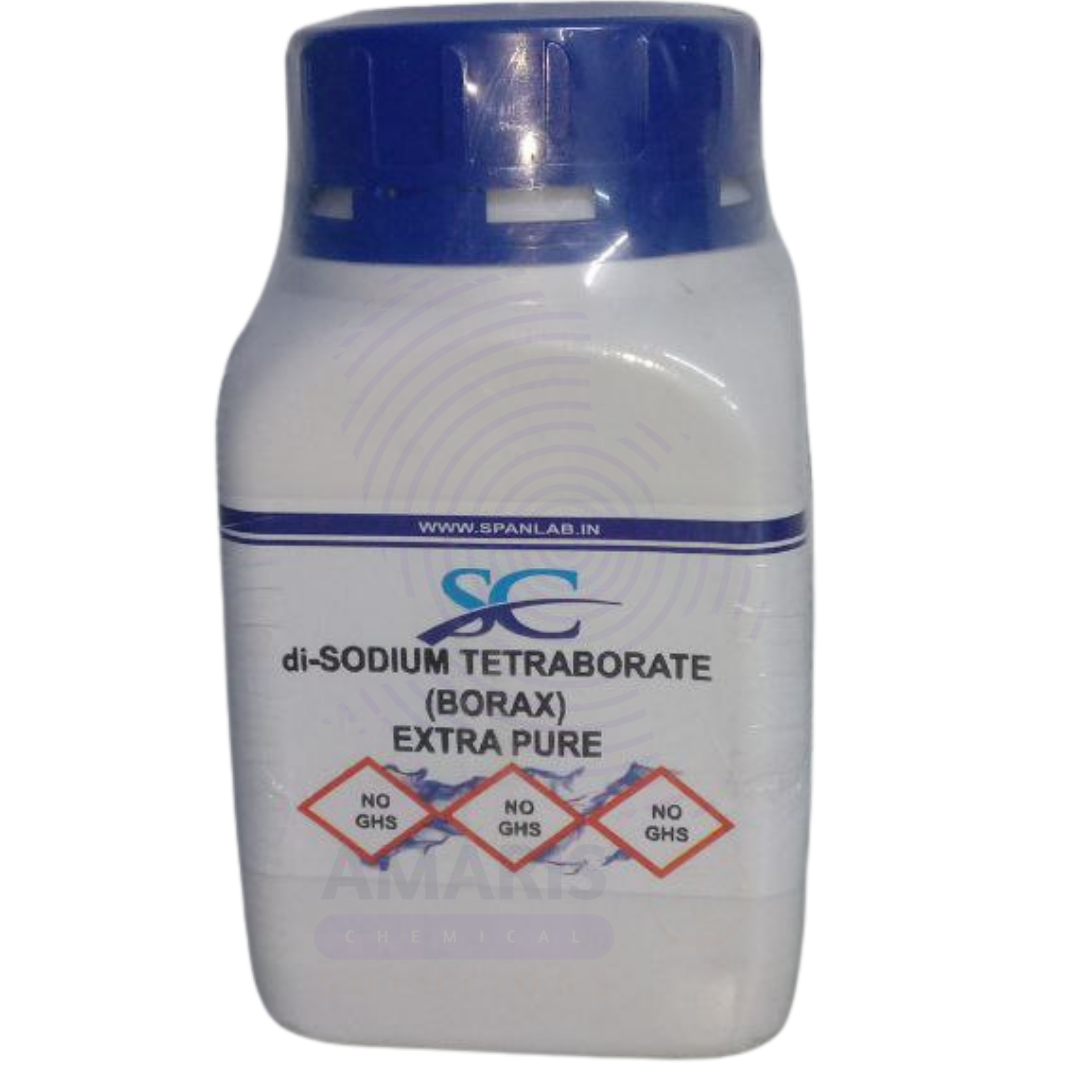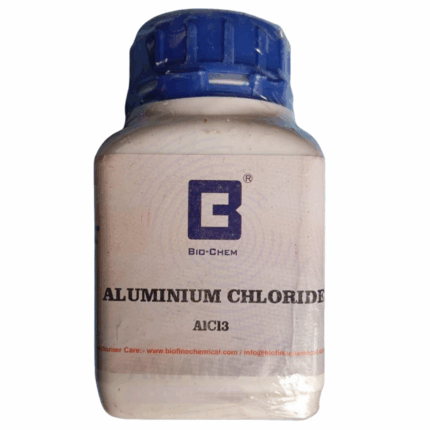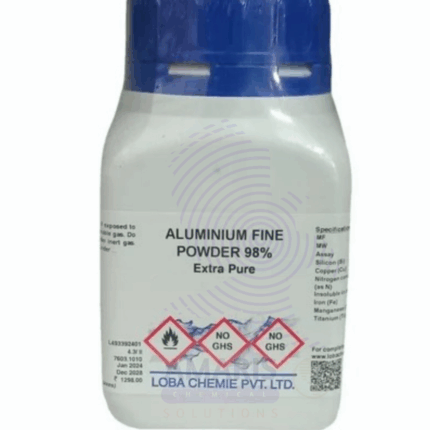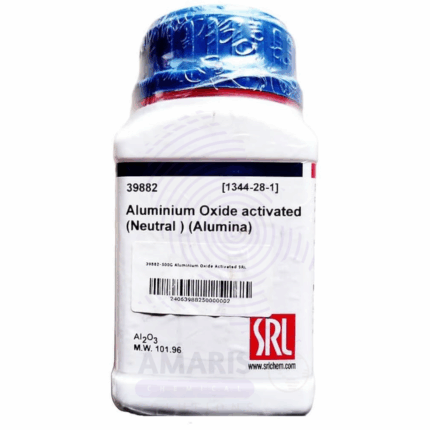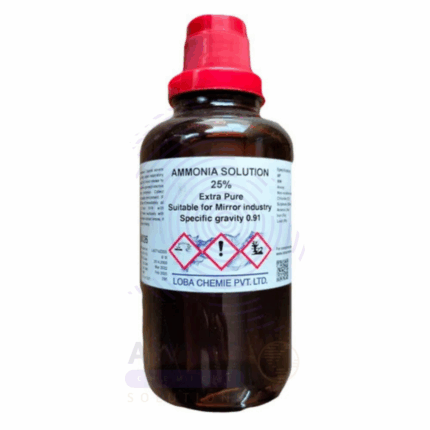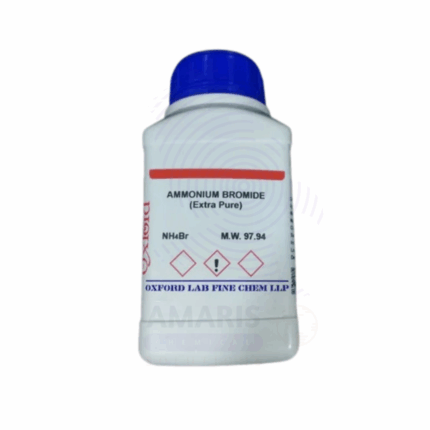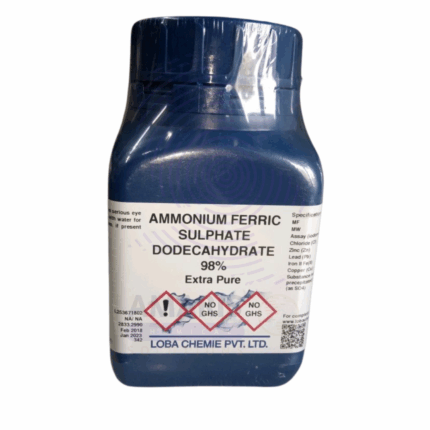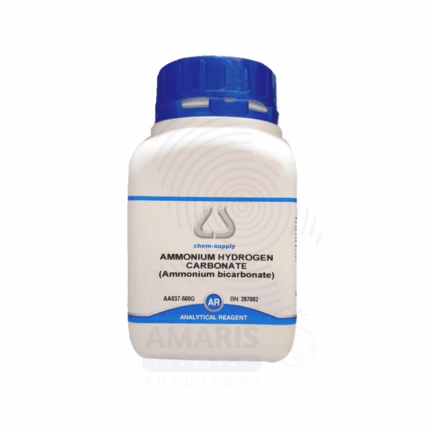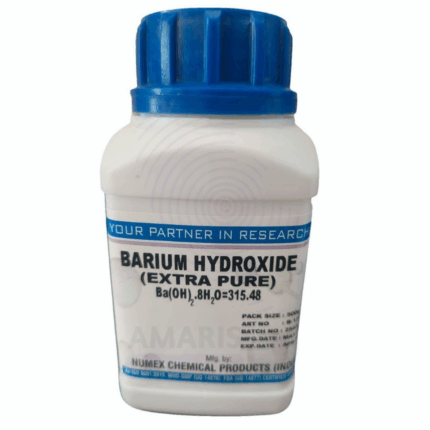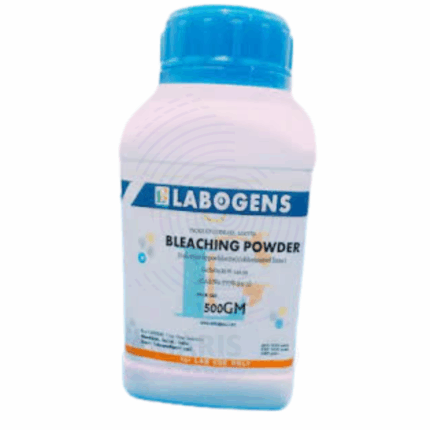
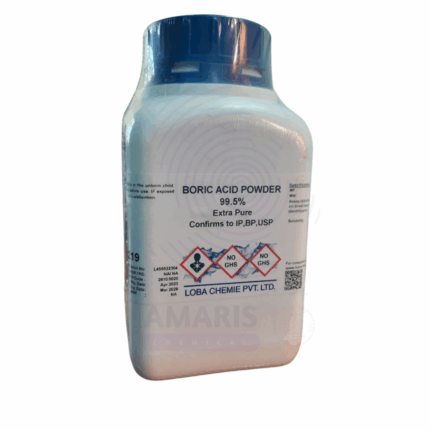
Borax Extra Pure
$ 18.00 Original price was: $ 18.00.$ 17.87Current price is: $ 17.87.
Borax Extra Pure, also known as sodium tetraborate decahydrate, is a high-purity crystalline compound widely used in laboratory applications involving buffer preparation, flame tests, and qualitative inorganic analysis. It serves as a valuable reagent in analytical chemistry for detecting metal ions, especially in borax bead tests, and is commonly used to prepare borate buffers for biochemical experiments due to its stable pH-regulating properties. Its ability to act as a mild alkali and complexing agent makes it suitable for various titration and solubility studies. The extra pure grade guarantees minimal contamination, ensuring accurate and consistent results in sensitive laboratory work. It should be stored in a tightly sealed container in a cool, dry environment, away from acids and moisture.
Borax Extra Pure
Primary Uses
- Buffering Agent
- Commonly used in preparing buffer solutions, especially in biochemical and enzymatic experiments due to its ability to maintain stable pH in alkaline ranges (pH ~9.2 when mixed with boric acid).
- Complexometric Titration Support
- Acts as a masking or stabilizing agent in EDTA titrations, helping to maintain proper metal ion balance.
- Reagent in Qualitative Inorganic Analysis
- Used in borax bead tests to identify transition metal ions based on the color of the molten bead formed upon heating with metal salts.
- Glass and Enamel Flux Studies
- Serves in research on glass formation and enamel behavior, where borax acts as a fluxing agent that lowers melting points and enhances flow properties.
Secondary Uses
- Microbiology & Molecular Biology Support
- Occasionally used in storage solutions for biological samples or as a component of certain staining buffers (e.g., in RNA gels).
- Demonstration of Hydration and Crystal Structures
- In educational labs, borax crystals are used to teach crystallization, water of hydration, and thermochemical changes.
- Polymer Slime Demonstrations
- Reacts with polyvinyl alcohol (PVA) in polymer cross-linking experiments, popular in educational chemistry demonstrations.
- Water Softening & Ion Exchange Experiments
- Used in teaching water hardness reduction, due to its mild alkalinity and ion-complexing ability.
| PACK SIZE |
500 grams Plastic Tin |
|---|
1. Basic Identification Attributes
- Product Name: Borax Extra Pure
- Other Names: Sodium Tetraborate Decahydrate, Disodium Tetraborate
- Chemical Formula: Na₂B₄O₇·10H₂O
- CAS Number: 1303-96-4
- HS Code: 2840.11.00
- Grade: Extra Pure (analytical reagent grade, suitable for lab use)
2. Physical & Chemical Properties
- Appearance: White crystalline powder or granules
- Odor: Odorless
- Molecular Weight: 381.37 g/mol
- Solubility in Water: Soluble (better in warm water)
- Melting Point: Loses water at ~75°C, melts at ~741°C (anhydrous)
- pH (1% solution): ~9.3 (alkaline)
- Stability: Stable under normal lab conditions
3. Safety & Hazard Attributes
- GHS Classification:
- Reproductive toxicity (Category 2 – suspected)
- Eye irritation (Category 2A)
- GHS Pictograms: ⚠️
- NFPA Ratings:
- Health: 1
- Flammability: 0
- Reactivity: 0
- Lab Hazards:
- Can irritate eyes and skin
- Harmful if ingested in large quantities
- Long-term exposure may affect fertility
- PPE:
- Gloves, goggles, lab coat
- Avoid inhaling dust
4. Storage & Handling Attributes
- Storage Conditions:
- Store in tightly closed containers
- Keep in a dry, cool place away from moisture
- Incompatible With:
- Strong acids (forms boric acid)
- Strong oxidizers
- Shelf Life:
- Stable indefinitely when stored properly
- Handling Notes:
- Minimize dust generation
- Do not store with acidic materials
5. Regulatory & Compliance Attributes
- Regulatory Status:
- Subject to reporting in some regions due to reproductive toxicity concerns
- UN Number: Not regulated for transport
- Disposal:
- Dispose of in accordance with local chemical waste guidelines
- Non-hazardous under most disposal classifications
6. Environmental & Health Impact
- Toxicity: Low acute toxicity, but potentially harmful in aquatic environments at high concentrations
- Biodegradability: Not applicable – mineral salt
- Health Effects:
- May irritate eyes and respiratory tract
- Chronic exposure linked to fertility issues in high doses
SAFETY PRECAUTIONS
- Personal Protective Equipment (PPE):
- Wear protective gloves, safety goggles, and lab coat.
- Use a dust mask or respirator if handling large quantities in powder form.
- Handling:
- Avoid creating and breathing dust.
- Avoid contact with skin, eyes, and clothing.
- Do not ingest. Wash hands thoroughly after handling.
- Storage:
- Store in a cool, dry, well-ventilated area.
- Keep containers tightly sealed.
- Protect from moisture and incompatible substances like strong acids.
- Incompatibilities:
- Reacts with strong acids to form boric acid and toxic fumes.
- Avoid exposure to excessive heat or water, which may alter chemical structure.
FIRST AID MEASURES
- Inhalation:
- Move to fresh air immediately.
- If breathing becomes difficult, seek medical attention.
- Skin Contact:
- Wash affected area with soap and water.
- Remove contaminated clothing.
- Eye Contact:
- Rinse immediately with plenty of water for at least 15 minutes.
- Seek medical help if irritation persists.
- Ingestion:
- Rinse mouth with water.
- Do not induce vomiting unless directed by medical personnel.
- Seek medical attention.
FIRE FIGHTING MEASURES
- Extinguishing Media:
- Use water spray, dry chemical, foam, or CO₂.
- Borax itself is non-flammable.
- Fire Hazards:
- When heated to decomposition, may emit boron oxides and sodium oxide fumes.
- Firefighter Protection:
Wear self-contained breathing apparatus (SCBA) and full protective gear.


 Preservatives(food)
Preservatives(food) Flavor Enhancers
Flavor Enhancers Acidulants
Acidulants Sweeteners
Sweeteners Antioxidants
Antioxidants Colorants(food)
Colorants(food) Nutraceutical Ingredients (food)
Nutraceutical Ingredients (food) Nutrient Supplements
Nutrient Supplements Emulsifiers
Emulsifiers
 Collectors
Collectors Dust Suppressants
Dust Suppressants Explosives and Blasting Agents
Explosives and Blasting Agents Flocculants and Coagulants
Flocculants and Coagulants Frothers
Frothers Leaching Agents
Leaching Agents pH Modifiers
pH Modifiers Precious Metal Extraction Agents
Precious Metal Extraction Agents
 Antioxidants(plastic)
Antioxidants(plastic) Colorants (Pigments, Dyes)
Colorants (Pigments, Dyes) Fillers and Reinforcements
Fillers and Reinforcements Flame Retardants
Flame Retardants Monomers
Monomers Plasticizers
Plasticizers Polymerization Initiators
Polymerization Initiators Stabilizers (UV, Heat)
Stabilizers (UV, Heat)
 Antifoaming Agents
Antifoaming Agents Chelating Agents
Chelating Agents Coagulants and Flocculants
Coagulants and Flocculants Corrosion Inhibitors
Corrosion Inhibitors Disinfectants and Biocides
Disinfectants and Biocides Oxidizing Agents
Oxidizing Agents pH Adjusters
pH Adjusters Scale Inhibitors( water)
Scale Inhibitors( water)
 Antioxidants(cosmetic)
Antioxidants(cosmetic) Emollients
Emollients Fragrances and Essential Oils
Fragrances and Essential Oils Humectants
Humectants Preservatives
Preservatives Surfactants(cosmetic)
Surfactants(cosmetic) Thickeners
Thickeners UV Filters
UV Filters
 Fertilizers
Fertilizers Soil Conditioners
Soil Conditioners Plant Growth Regulators
Plant Growth Regulators Animal Feed Additives
Animal Feed Additives Biostimulants
Biostimulants Pesticides (Herbicides, Insecticides, Fungicides)
Pesticides (Herbicides, Insecticides, Fungicides)
 Active Pharmaceutical Ingredients (APIs)
Active Pharmaceutical Ingredients (APIs) Excipients
Excipients Solvents(pharmaceutical)
Solvents(pharmaceutical) Antibiotics
Antibiotics Antiseptics and Disinfectants
Antiseptics and Disinfectants Vaccine Adjuvants
Vaccine Adjuvants Nutraceutical Ingredients (pharmaceutical)
Nutraceutical Ingredients (pharmaceutical) Analgesics & Antipyretics
Analgesics & Antipyretics
 Analytical Reagents
Analytical Reagents Solvents(lab)
Solvents(lab) Chromatography Chemicals
Chromatography Chemicals Spectroscopy Reagents
Spectroscopy Reagents microbiology-and-cell-culture-reagents
microbiology-and-cell-culture-reagents Molecular Biology Reagents
Molecular Biology Reagents Biochemical Reagents
Biochemical Reagents Inorganic and Organic Standards
Inorganic and Organic Standards Laboratory Safety Chemicals
Laboratory Safety Chemicals Specialty Laboratory Chemicals(Special Laboratory Equipment)
Specialty Laboratory Chemicals(Special Laboratory Equipment)
 Demulsifiers
Demulsifiers Hydraulic Fracturing Fluids
Hydraulic Fracturing Fluids Scale Inhibitors(oil)
Scale Inhibitors(oil) Surfactants(oil)
Surfactants(oil) Drilling Fluids
Drilling Fluids
 Dyes and Pigments
Dyes and Pigments Bleaching Agents
Bleaching Agents Softening Agents
Softening Agents Finishing Agents
Finishing Agents Antistatic Agents
Antistatic Agents
 Admixtures
Admixtures Waterproofing Agents
Waterproofing Agents Sealants and Adhesives
Sealants and Adhesives Curing Compounds
Curing Compounds Concrete Repair Chemicals
Concrete Repair Chemicals Anti-Corrosion Coatings
Anti-Corrosion Coatings
 Surfactants(cleaning)
Surfactants(cleaning) Builders
Builders Enzymes
Enzymes Solvents (Cleaning)
Solvents (Cleaning) Fragrances
Fragrances
 Electronic Chemicals
Electronic Chemicals Catalysts
Catalysts Lubricants
Lubricants Photographic Chemicals
Photographic Chemicals Refrigerants
Refrigerants Automotive chemicals
Automotive chemicals Pyrotechnic Chemicals
Pyrotechnic Chemicals
 Biodegradable Surfactants
Biodegradable Surfactants Bio-based Solvents
Bio-based Solvents Renewable Polymers
Renewable Polymers Carbon Capture Chemicals
Carbon Capture Chemicals Wastewater Treatment Chemicals
Wastewater Treatment Chemicals
 Pigments
Pigments Solvents(paint)
Solvents(paint) Specialty Coatings
Specialty Coatings Binders/Resins
Binders/Resins Additives
Additives Driers
Driers Anti-Corrosion Agents
Anti-Corrosion Agents Functional Coatings
Functional Coatings Application-Specific Coatings
Application-Specific Coatings
 Fresh Herbs
Fresh Herbs Ground Spices
Ground Spices Whole Spices
Whole Spices Spice Blends
Spice Blends Dried Herbs
Dried Herbs
 Leavening Agents
Leavening Agents Dough Conditioners
Dough Conditioners Flour Treatments
Flour Treatments Fat Replacers
Fat Replacers Decoratives
Decoratives Preservatives(baking)
Preservatives(baking)
 Plasticizers & Softeners
Plasticizers & Softeners Reinforcing Agents
Reinforcing Agents Adhesion Promoters
Adhesion Promoters Vulcanizing Agents
Vulcanizing Agents Antidegradants
Antidegradants Blowing Agents
Blowing Agents Fillers & Extenders
Fillers & Extenders Accelerators & Retarders
Accelerators & Retarders